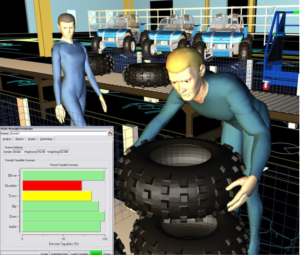With all the enthusiasm about industry 4.0, it’s easy to imagine a future of factories run entirely by artificial intelligence. But in reality, we’re still going to have lots of people working in factories and distribution centers for the foreseeable future. So why wouldn’t we use technology to create a safer, healthier, and more productive experience for all?
This is where digital technology and ergonomics have a major role to play in industry 4.0.
Every day, more companies big and small are using software to optimize health, safety, and productivity in their workspaces. They do this with tools like Process Simulate Human, a feature set of Siemens Tecnomatix software that allows you to create virtual replicas of your workspace and employees, then run AI-powered simulations to determine the ideal ways for you to set up your workspace and employee tasks.

Unparalleled Accuracy
It’s impossible to overstate how well this type of software can reduce injury and optimize performance. If a simulated worker performs a high-risk or inefficient movement, the system will flag it and make recommendations on how to reduce this risk.
“Process Simulate Human creates a true human model by drawing on an unparalleled amount of biometric data,” says Allison Stephens, a professor and coordinator of the Advanced Ergonomics Studies Program at Fanshawe College. “We’re not just talking about seeing pain in the model’s back. I can see how much compression there is in a specific disc in that model’s back. That kind of data is crucial to a good ergonomic study. Plus if offers you the ability to model your exact workplace environment with a fidelity you just don’t see in other software out there.”
From Nice-to-Have to Must-Have
Prior to her role at Fanshawe, Stephens spent years working with this kind of simulation software at Ford Motors. There, she used it to constantly improve the company’s use of factory space for maximum health, safety, and efficiency. This cutting-edge approach to ergonomics and plant management might have once been available only to the largest and most powerful companies. But now, we’re seeing more small-to-medium-sized companies adopting this technology every day. This turns it from a nice-to-have into a must-have in the competitive global marketplace.
“It isn’t so much about whether a company should use this type of solution as it’s a question of how they use it,” Stephens says. “Some companies have internal engineers who can benefit from using this solution constantly. Others would benefit from training some of their engineers to start using it semi-regularly.”
Some smaller companies require the benefits of this software, but only on an as-needed basis. One popular route for these companies is to work with ergonomic consultants who can access this software to provide on-demand assessment, reporting, and recommendations.
“I certainly know of some great ergonomic experts who find this product incredibly powerful,” Stephens adds. “They’ve used this software to distinguish themselves as high-calibre firms in this area.”
Your Next Steps
Whether you work for a large company, SME, or ergonomics consultancy, Process Simulate Human can bring enormous benefits to you and your team. With companies around the world finding new efficiencies every day, using this kind of software to maximize health, safety, and productivity is a must-have.
To learn more about this software, please reach out to us at Longterm Technology Services. We are experts in providing software, training, and consulting to help businesses become leaders in industry 4.0. We have specialized expertise working with ergonomic experts to make sure the world gets the most out of software like Process Simulate Human and Siemens Tecnomatix.


